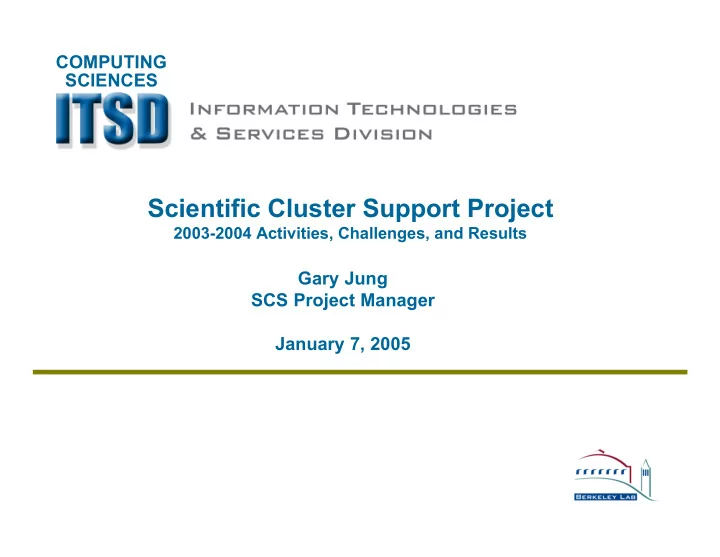

COMPUTING SCIENCES Scientific Cluster Support Project 2003-2004 Activities, Challenges, and Results Gary Jung SCS Project Manager January 7, 2005
COMPUTING SCIENCES The need for Computing • Why is scientific computing so important to our researchers? – Traditional methods • Theoretical approach • Experimental approach – Computational approach is now recognized as important tool in scientific research • Data analysis • Large scale simulation and modeling of physical or biological processes
COMPUTING A Brief History of SCIENCES Computing at Berkeley Lab • The 1970’s and early 1980’s – Central computing – CDC 6000 and 7600 Supercomputers • The 1980’s – Minicomputers – Digital Equipment Corp VAX and 8600 series systems – Interactive timesharing computing • The 1990’s – Distributed networked computing – Computing at the desktop – Institutional central computing fades away – The “Gap” • 2000 - Linux cluster computing starts to emerge at Berkeley Lab
COMPUTING SCIENCES What is a Linux cluster? • Commodity Off The Shelf (COTS) parts LBLNet • Open source software (Linux) • Single master/multiple slave(compute) node Master Node architecture – External view of the cluster is as a single unit for Compute Node – managing, configuration, communication Cluster Network Compute Node – Organized dedicated network communication among nodes Compute Node • Similar or identical software running on each node Compute Node • Job scheduler • Parallel programming software - Message Passing Compute Node Interface (MPI)
COMPUTING Scientific Cluster Support SCIENCES Project Initiated • 2002 - MRC Working Group recommends that ITSD provide support for Linux Clusters. • December 2002 - SCS Program approved – $1.3M Four-year program started January 2003 – Ten strategic science projects are selected – Projects purchase their own Linux clusters – ITSD provides consulting and support • Strategy – Use proven technical approaches that enable us to provide production capability – Adopt standards to facilitate scaling support to several clusters • Goals – More effective science – Enable our scientists to use and take advantage of computing – HPC that works. Avoid lost time and expensive mistakes
COMPUTING SCIENCES Participating Science Projects Semiclassical Molecular Reaction Dynamics: Chemical PI: William Miller Methodological Development and Application to 40 Intel Xeon processors Sciences Complex Systems Chemical PI: Martin Head- Parallel electronic structure theory 42 AMD Opteron processors Sciences Gordon Chemical PI: William Lester Quantum Monte Carlo for electronic structure 46 AMD Athlon processors Sciences Materials Signaling and Mechanical Responses Due to PI: Arup Chakraborty 96 AMD Athlon processors Sciences Biomolecular Binding Material PI; Steve Louie Molecular Foundry 72 AMD Opteron processors Sciences Marvin Cohen Structural Genomics of a Minimal Genome Computational Structural & Functional Genomics PI/Contact: Physical Kim/Adams/ 60 Intel Xeon processors A Structural Classification of RNA Bioscience Brenner/Holbrook Nudix DNA Repair Enzymes from Deinococcus radiodurans Airflow and Pollutant Transport in Buildings Environmental Energy PI: Gadgil/Brown Regional Air Quality Modeling 24 AMD Athlon processors Technologies Combustion Modeling Earth Sciences PI: Hoversten/Majer Geophysical Subsurface Imaging 50 Intel Xeon processors Computational Analysis of cis-Regulatory Content of Life Sciences PI: Michael Eisen 40 Intel Xeon processors Animal Genomes Protein Crystallography and SAXS data Analysis for Life Sciences PI: Cooper/Tainer 20 Intel Xeon processors Sibyls/SBDR Gretina Detector - Signal deposition and event Nuclear Sciences PI: I-Yang Lee 16 AMD Opteron processors reconstruction
COMPUTING SCIENCES Past Challenges • Scheduling – Funding availability – Variance in customer readiness • Security – Export control – One-time password tokens – Firewall • Software – Licensing LBNL developed software – Red Hat Enterprise Linux
COMPUTING SCIENCES Accomplishments • 14 clusters in production – 10 SCS funded, 3 fully recharged, 1 ITSD test cluster – 698 processors online • Warewulf cluster software – Standard SCS cluster distribution – University of Kentucky KASY0 supercomputer • ITSD at Supercomputing 2003 • Enabling science – Chakraborty T-cell discovery - Oct 2003 – Lester INCITE work on Photosynthesis - Nov 2004
COMPUTING SCIENCES Accomplishments • Driving down costs – Standardization of architecture and toolset – Outsourcing of various pieces – Develop lower cost staff – Competitive bid procurement • About 10% savings – Benchmarking costs • Comparison to postdocs • Comparison to other Labs
COMPUTING SCIENCES Factors to our Success • Initial funding was key to get started • Prominent scientists were our customers • Talented, motivated staff – Creative, but focused on production use – Development of technical depth • Adherence to standards • Supportive Steering Committee • Positive feedback
COMPUTING New Challenges SCIENCES • Larger systems – Scalability issues - e.g. parallel filesystems – Moving up the technology curve - Infiniband, PCI Express – Assessing integration risks • Increasing cluster utilization • Harder problems to debug • Charting path forward
COMPUTING SCIENCES What’s next? • Upcoming projects – Earth Sciences 256 processor cluster - Spring 2005 – Molecular Foundry 256 processor cluster - Dec 2005 – Gretina 750 processor cluster 2007 • Follow-on to SCS – SCS approach vs. large institutional cluster – Grids
COMPUTING SCIENCES Clusters #1 and #10 PI: Arup Chakraborty Materials Sciences Division 96 AMD 2200+ MP processors 48 GB aggregate memory 1 TB disk storage Fast Ethernet interconnect 345 Gflop/s (theoretical peak) PI: Steve Louie and Marvin Cohen MSD Molecular Foundry 72 AMD Opteron 2.0 Ghz 64-bit processors 72 GB aggregate memory 2 TB disk storage Myrinet interconnect 288 Gflop/s (theoretical peak)
COMPUTING SCIENCES Installation
Recommend
More recommend